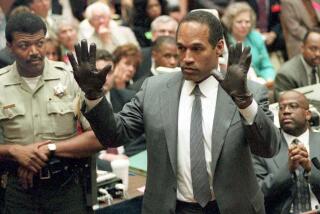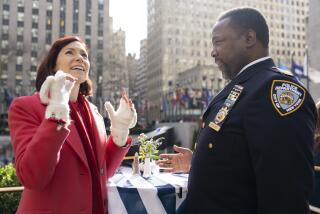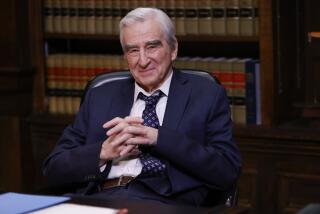‘Crime-Time’ Shows : TV Making Arm of the Law Longer
CARROLLTON, Tex. — Thirty seconds to air time, and Miss America 1983, Debra Sue Maffett, is bleary. It is, after all, 5:29 a.m. But out there in television land, Maffett knows, viewers already are waiting.
“Camera two, a two-shot with music,” the director orders as Maffett stifles a last yawn, “and fade up.”
It looks like ABC’s “Good Morning America” or NBC’s “Today” show. This, however, is LETN--the Law Enforcement Television Network. And for the next hour, this is “Roll Call.”
With Maffett as co-host, the viewers--all of them cops--will learn about Jamaican gangs, a police chase through Oklahoma and the wanted suspect of the day. “Notice,” says the narrator as the fugitive’s photo appears on screen, “that his right nose wall is thinner than the left.”
Benefits TV and Police
Though less than a year old, LETN is beaming the same kind of quasi-news and information 24 hours a day to more than 600 paying police agencies nationwide from its studios in this suburb north of Dallas.
The fledgling network seemingly has discovered not only a viable commercial market but a niche in a burgeoning phenomenon: the growing relationship between television and law enforcement to the apparent benefit of both.
From LETN’s programs intended for police only, to syndicated shows that openly solicit the public’s help in catching criminals by re-enacting crimes, to local news departments that involve themselves directly in crime fighting, officers are finding in TV a powerful and increasingly willing ally.
Broadcast executives say the trend simply reflects television’s effort to accommodate the public’s concern about rising crime and its fascination for those behind the badge.
‘New Wave of Journalism’
The effort has spawned a plethora of reality-based or so-called “crime-time” television shows--”Unsolved Mysteries,” “Cops” and “Cop Talk” among them--which invariably cast law enforcement in an unquestioning and sympathetic light.
“We have tapped into a great frustration on the part of the American public . . .,” said Michael Linder, a former KCBS reporter from Los Angeles who is executive producer of the Fox network’s popular “America’s Most Wanted.”
“What you are witnessing is the birth of a new era and a new wave of journalism,” Linder said. “Citizens want to better understand and help the police, and there is a willingness by television to help do that.”
Not everyone is as enamored of the alliance.
Some sociologists and civil libertarians contend that crime-time television is helping stir an insecurity, if not paranoia, among the public.
“By inducing insecurity about crime, people are more willing to tolerate repression so long as it adds to their sense of security,” said George Gerbner, communications professor at the University of Pennsylvania and an expert on television violence. “These kinds of programs have gotten to be a major social control instrument.”
Some journalism educators, meanwhile, say that television is blurring the line between news and entertainment by re-enacting crimes and cooperating directly with law enforcement. In playing partisan participant rather than objective observer, critics argue, the media’s traditional, self-assumed role as watchdog is threatened.
“I’m appalled by what’s happening,” said Tom Goldstein, dean of the journalism graduate school at UC Berkeley. “Let the police be the police. If they are having a hard time keeping up with crime, we should be writing stories about how inadequate their resources are, not playing cops and robbers.”
Regardless of the debate over ethics, there are, by some estimates, as many as 18 other television series in various stages of development or production that portray real-life cops and robbers. One program now in the wings has as its theme police psychics.
Real-Life Crime Stories
The crime-time genre’s latest offering, Current Trends Productions’ syndicated “Crimewatch Tonight,” premiered nationally Sept. 11. The nightly, half-hour show hosted by veteran TV newsman Ike Pappas features real-life crime stories. True to form, it also solicits the public’s help in finding fugitives.
In addition, the show promises to be “the only program of its kind to offer the viewing audience valuable information on crime prevention.”
While some detectives complain that they are swamped by worthless tips generated by these types of programs, most say they are gratified nonetheless by television’s interest in their investigations.
In the case of “America’s Most Wanted,” which premiered in February, 1988, officers from municipal police departments are flown each week to Washington at the show’s expense when their case is to be re-enacted. During and after the broadcast, the officers remain on the set to receive telephoned tips from viewers encouraged to call a toll-free number.
As of Sept. 1, more than 150,000 tips had been logged, resulting in the arrests of 65 of 102 suspects profiled, according to Linder. Alleged murderers, rapists, kidnapers, escape artists and even a madam have been “snitched off” by the citizenry and captured after being depicted on 125 Fox affiliate stations.
Arrested 35 Minutes After Show
In one case, authorities were alerted and the suspect was arrested 35 minutes after his alleged crime was re-enacted.
“The national community, “ Linder said, “has realized how thin the ‘Thin Blue Line’ really is.”
At the same time, the Thin Blue Line apparently has realized how influential television really is. Recent studies have shown that 98% of the 92.1 million households in America have at least one TV set which, on average, is turned on for more than six hours a day.
An A.C. Neilsen Co. survey found that 9.2 million households had tuned in on Sunday night, Sept. 10, to “America’s Most Wanted,” making it the nation’s 42nd most watched show. “Cheers,” the nation’s most-watched show that week, had an audience of nearly 17 million households.
In the same survey, NBC’s 2-year-old “Unsolved Mysteries,” which also re-enacts crimes and seeks help from viewers in solving them, ranked 11th, just ahead of “Night Court” and just behind “60 Minutes.”
The ratings more than please the police, who may be among crime-time programming’s most avid fans.
Public Support for Police
“The partnership between law enforcement, the public and TV is working,” said Special Agent Scott A. Nelson, the FBI’s chief of public affairs. “The FBI guys . . . end up with a great deal of public support; the TV guys are making money by providing a bit of entertainment and news journalism; and the public has fewer criminals on the street to worry about.”
There is little new in law enforcement’s asking for the public’s help in the hunt for wanted suspects. U.S. marshals two centuries ago began tacking up reward posters along highways and in town squares, hoping that conscientious citizens would recognize the accused and turn them in.
The strategy took a formal turn in 1950, after United Press International distributed a story about the “toughest guys” wanted by the FBI. The report generated considerable publicity, prompting FBI Director J. Edgar Hoover to create the bureau’s “Ten Most Wanted” list.
Agents began plastering posters and accompanying, detailed descriptions of wanted criminals in post offices and public buildings nationwide. If a crook had a distinctive scar, tattoo or mole, it was revealed to the public along with the invariable warning that the bad guy--or gal--was likely “armed and dangerous.”
Within a year, nine of the 20 profiled suspects had been arrested after citizens turned them in. To date, according to FBI figures, tips from the public have resulted in the capture of 121 of 426 fugitives who have appeared on the most wanted list.
Posters: Limited Success
The FBI has also asked newspapers to publish fugitive posters. But that aspect of the most wanted program has had only limited success over the years, according to the FBI’s Nelson and other agents.
Some editors insist that there is simply more significant news to run and not enough space in the daily paper; others argue that to reprint the posters without response from the suspect would violate the newspaper’s objectivity as well as the suspect’s civil rights.
Yet as crime in America has increased--there were 637 violent crimes for every 100,000 Americans in 1988, a more than 100% jump over 1968--there have been increasing instances of television disregarding traditional, some would say archaic, journalistic concerns in its direct support of law enforcement.
In the Miami-Ft. Lauderdale area, for example, camera crews from ABC-affiliate station WPGL’s weekly “Eye on Crime” ride side-by-side with police officers, shooting live footage of crimes in progress. The show, which also relies on police videotape and features a toll-free number, is hosted by WPGL’s news anchorman. The show’s resident commentator is a local police commander.
Television stations in several other cities routinely allow authorities to ride aboard their news helicopters during police searches or pursuits.
In Denver last year, a helicopter pilot and cameraman for the local NBC-affiliate station even went so far as to hover directly in front of a robbery suspect who had earlier taken a hostage and run over a policeman. With the helicopter blocking the suspect’s escape, officers were able to catch up to him. The suspect was then killed in a confrontation with his pursuers.
The pilot and cameraman later were made honorary Denver police lieutenants.
That sort of interaction with law enforcement may make some members of the news media uncomfortable--but not all.
“I don’t know why, as a journalist, I have to be in the middle between law-abiding citizens and criminals,” said Jeff Greenfield, media and politics correspondent for ABC News. “I am for people who do not mug, rape, steal or kill.”
Nor, said Greenfield, is he ethically troubled by shows that “throw pictures of wanted people up on a TV screen. I just wonder whether it accomplishes much in the long run.”
Indeed, while “America’s Most Wanted” can take credit for helping capture 65 fugitives, U.S. Justice Department records show that as of Sept. 1, there were more than 325,000 other people in America wanted on serious misdemeanor or felony arrest warrants.
Better Image, More Support
Regardless of whether television’s involvement has any significant impact on crime, police officers still say they benefit, both in image and at budget time, from crime-time shows that realistically portray their struggle against a surging criminal tide.
Cops have always been lionized by television. The problem, according to producers today, has been that most shows have portrayed the police as flakes (“Car 54,” “The Andy Griffith Show”), automatons (“Dragnet,” “Adam 12”) or hotheaded gunfighters (“Starsky & Hutch”).
“People today want to know who the police really are, “ said Sonny Grosso, a former New York City detective-turned television producer who gained fame by helping crack the notorious “French Connection” heroin case in 1962. “We’ve come a long way from ‘Just the facts, ma’am.’ ”
Accordingly, Grosso hosts “Cop Talk: Behind the Badge,” a syndicated, weekly show that began airing in June in 75 U.S. television markets, including Los Angeles.
A new panel of police officers appears on the show each week to discuss law enforcement-related themes. Both Grosso and members of the show’s live audience, many of whom are police officers themselves, ask questions of the guests. Their inquiries, however, are rarely the type that go for the jugular.
“Tell me,” Grosso demanded of one recent guest, a female captain on the New York City Police Department’s version of SWAT. “What’s it like being a pretty lady in a gung-ho unit?”
Later in the same show, an audience member raised his hand as if to ask a question. “I don’t have a question,” he admitted after Grosso passed him the microphone. “I’d just like to applaud all the police in general throughout the world for what they do.”
With that, the rest of the studio audience broke into applause.
‘The Police Station’
Cheering law enforcement is also an essential theme behind the Law Enforcement Television Network, which touts itself as “The Police Station” in its promotional literature.
LETN’s president, former Dallas police chief Billy Prince, makes no excuses for the fact that the network’s programming is openly subjective.
“We’re not going to show the bleeding heart socialist’s position,” Prince said. “We’re going to show the officers’ side . . . so that when they get up and walk out of that assembly room (after watching LETN), they’re going to feel better about themselves.”
Police departments in Austin, Cincinnati, Dallas, Little Rock and Minneapolis have signed up, according to LETN officials, and several larger agencies, including the Los Angeles police and sheriff’s departments, are considering.
A handful of smaller police departments in Southern California, including those in Santa Monica, Inglewood and Cypress, already have subscribed to LETN’s satellite service.
“We’re just tickled pink with it,” said Ron Lowenberg, chief of Cypress’ 53-officer force. “It’s less expensive than a training manager.”
Round-the-Clock Shows
For $288 to $588 a month, depending on its size, a police department will receive round-the-clock LETN shows with no-nonsense names like “Training for Survival,” “Alert, Alive & Well,” and “Street Beat.”
There are also news updates throughout the day on significant but not necessarily spectacular busts around the country. The arrests of three counterfeiters in North Dakota is the type of story likely to make the LETN news.
Police television for police is the brainchild of Carl Westcott, a former Dallas car dealer who in 1986 started the Automotive Satellite Network, which today broadcasts car-related programming to more than 5,000 of the 25,000 auto dealerships in North America.
“We saw the same type of demographics in law enforcement,” Westcott said. “There is a huge requirement for constantly updating communications, training and education. And when you consider that we are a society raised on television, it makes sense to use it for more than entertainment.”
There are more than 16,500 law enforcement agencies in the United States, all potential LETN subscribers. Westcott figures the break-even point is 2,000.
Millions Invested
Toward that end, his company, Westcott Communications, has spent millions in Carrollton, gutting a one-time Apple computer warehouse, then refurbishing it with top-of-the-line studio sets and the best video production equipment available.
The company, which has about 200 employees, arranged a satellite tie-in with CBS News to pick up police-related stories that do not make the nightly news. Westcott also hired a stable of young, experienced on-air talent to deliver news and information with a clear pro-law-enforcement slant.
Among those hired was the blonde, blue-eyed Maffett, who gained widespread publicity a few years back amid reports that she had extensive cosmetic surgery before being crowned Miss America.
Before coming to work for LETN this spring, Maffett co-hosted “PM Magazine” on KTTV Channel 11 in Los Angeles, and was the aerobics instructor for “Alive and Well,” a nationally syndicated health show.
“I was really looking for a show that would make a difference,” Maffett said. “I had no idea what the lives of police officers were like before. I went riding with a patrol officer and it was literally the most exciting thing I’d ever done.”
On this day, Maffett is tackling one of the most emotional on-air interviews she’s ever done. The subjects are Steven McDonald, a New York City police officer who remains a quadriplegic after being shot while on duty in 1986, and his wife, Patti Ann.
Patti Ann dabs at her eyes as McDonald, strapped to a wheelchair and forced to breathe by respirator, talks in labored sentences about his wife’s love, of his love of law enforcement, and of the heroism demonstrated by unheralded cops every day.
Maffett swallows hard. She seems about to cry but doesn’t.
“Thank you,” she says to her guests, “for re-connecting us up with our hearts.”
More to Read
The complete guide to home viewing
Get Screen Gab for everything about the TV shows and streaming movies everyone’s talking about.
You may occasionally receive promotional content from the Los Angeles Times.






